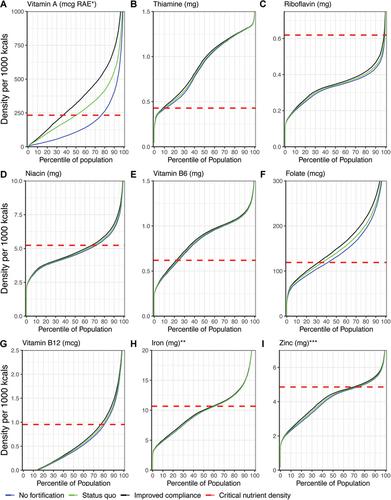当前位置:
X-MOL 学术
›
Ann. N. Y. Acad. Sci.
›
论文详情
Our official English website, www.x-mol.net, welcomes your
feedback! (Note: you will need to create a separate account there.)
Modeling food fortification contributions to micronutrient requirements in Malawi using Household Consumption and Expenditure Surveys
Annals of the New York Academy of Sciences ( IF 4.1 ) Pub Date : 2021-09-28 , DOI: 10.1111/nyas.14697 Kevin Tang 1, 2 , Katherine P Adams 3 , Elaine L Ferguson 1 , Monica Woldt 2, 4 , Alexander A Kalimbira 5 , Blessings Likoswe 6 , Jennifer Yourkavitch 2, 7 , Benjamin Chrisinger 8 , Sarah Pedersen 9 , Lucia Segovia De La Revilla 1 , Omar Dary 10 , E Louise Ander 11, 12 , Edward J M Joy 1
Annals of the New York Academy of Sciences ( IF 4.1 ) Pub Date : 2021-09-28 , DOI: 10.1111/nyas.14697 Kevin Tang 1, 2 , Katherine P Adams 3 , Elaine L Ferguson 1 , Monica Woldt 2, 4 , Alexander A Kalimbira 5 , Blessings Likoswe 6 , Jennifer Yourkavitch 2, 7 , Benjamin Chrisinger 8 , Sarah Pedersen 9 , Lucia Segovia De La Revilla 1 , Omar Dary 10 , E Louise Ander 11, 12 , Edward J M Joy 1
Affiliation

|
Large-scale food fortification may be a cost-effective intervention to increase micronutrient supplies in the food system when implemented under appropriate conditions, yet it is unclear if current strategies can equitably benefit populations with the greatest micronutrient needs. This study developed a mathematical modeling framework for comparing fortification scenarios across different contexts. It was applied to model the potential contributions of three fortification vehicles (oil, sugar, and wheat flour) toward meeting dietary micronutrient requirements in Malawi through secondary data analyses of a Household Consumption and Expenditure Survey. We estimated fortification vehicle coverage, micronutrient density of the diet, and apparent intake of nonpregnant, nonlactating women for nine different micronutrients, under three food fortification scenarios and stratified by subpopulations across seasons. Oil and sugar had high coverage and apparent consumption that, when combined, were predicted to improve the vitamin A adequacy of the diet. Wheat flour contributed little to estimated dietary micronutrient supplies due to low apparent consumption. Potential contributions of all fortification vehicles were low in rural populations of the lowest socioeconomic position. While the model predicted large-scale food fortification would contribute to reducing vitamin A inadequacies, other interventions are necessary to meet other micronutrient requirements, especially for the rural poor.
中文翻译:

使用家庭消费和支出调查模拟食品强化对马拉维微量营养素需求的贡献
如果在适当条件下实施,大规模食品强化可能是增加食品系统中微量营养素供应的一种具有成本效益的干预措施,但目前的战略是否能够公平地惠及微量营养素需求量最大的人群尚不清楚。本研究开发了一个数学建模框架,用于比较不同背景下的设防场景。通过家庭消费和支出调查的二次数据分析,它被应用于模拟三种强化载体(油、糖和小麦粉)对满足马拉维膳食微量营养素需求的潜在贡献。我们估计了强化载体的覆盖率、饮食的微量营养素密度,以及未怀孕、非哺乳期妇女对九种不同微量营养素的表观摄入量,在三种食品强化情景下,并按不同季节的亚群进行分层。油和糖具有很高的覆盖率和表观消费量,预计它们结合起来会提高饮食中维生素 A 的充足率。由于表观消费量低,小麦粉对估计的膳食微量营养素供应贡献不大。在社会经济地位最低的农村人口中,所有强化车辆的潜在贡献都很低。虽然该模型预测大规模食品强化将有助于减少维生素 A 的不足,但还需要采取其他干预措施来满足其他微量营养素的需求,尤其是对农村贫困人口而言。预计会提高饮食中维生素 A 的充足性。由于表观消费量低,小麦粉对估计的膳食微量营养素供应贡献不大。在社会经济地位最低的农村人口中,所有强化车辆的潜在贡献都很低。虽然该模型预测大规模食品强化将有助于减少维生素 A 的不足,但还需要采取其他干预措施来满足其他微量营养素的需求,尤其是对农村贫困人口而言。预计会提高饮食中维生素 A 的充足性。由于表观消费量低,小麦粉对估计的膳食微量营养素供应贡献不大。在社会经济地位最低的农村人口中,所有强化车辆的潜在贡献都很低。虽然该模型预测大规模食品强化将有助于减少维生素 A 的不足,但还需要采取其他干预措施来满足其他微量营养素的需求,尤其是对农村贫困人口而言。
更新日期:2021-09-28
中文翻译:

使用家庭消费和支出调查模拟食品强化对马拉维微量营养素需求的贡献
如果在适当条件下实施,大规模食品强化可能是增加食品系统中微量营养素供应的一种具有成本效益的干预措施,但目前的战略是否能够公平地惠及微量营养素需求量最大的人群尚不清楚。本研究开发了一个数学建模框架,用于比较不同背景下的设防场景。通过家庭消费和支出调查的二次数据分析,它被应用于模拟三种强化载体(油、糖和小麦粉)对满足马拉维膳食微量营养素需求的潜在贡献。我们估计了强化载体的覆盖率、饮食的微量营养素密度,以及未怀孕、非哺乳期妇女对九种不同微量营养素的表观摄入量,在三种食品强化情景下,并按不同季节的亚群进行分层。油和糖具有很高的覆盖率和表观消费量,预计它们结合起来会提高饮食中维生素 A 的充足率。由于表观消费量低,小麦粉对估计的膳食微量营养素供应贡献不大。在社会经济地位最低的农村人口中,所有强化车辆的潜在贡献都很低。虽然该模型预测大规模食品强化将有助于减少维生素 A 的不足,但还需要采取其他干预措施来满足其他微量营养素的需求,尤其是对农村贫困人口而言。预计会提高饮食中维生素 A 的充足性。由于表观消费量低,小麦粉对估计的膳食微量营养素供应贡献不大。在社会经济地位最低的农村人口中,所有强化车辆的潜在贡献都很低。虽然该模型预测大规模食品强化将有助于减少维生素 A 的不足,但还需要采取其他干预措施来满足其他微量营养素的需求,尤其是对农村贫困人口而言。预计会提高饮食中维生素 A 的充足性。由于表观消费量低,小麦粉对估计的膳食微量营养素供应贡献不大。在社会经济地位最低的农村人口中,所有强化车辆的潜在贡献都很低。虽然该模型预测大规模食品强化将有助于减少维生素 A 的不足,但还需要采取其他干预措施来满足其他微量营养素的需求,尤其是对农村贫困人口而言。











































 京公网安备 11010802027423号
京公网安备 11010802027423号